analysis Asia
11th-hour US tariff discounts for Malaysia, Thailand and Cambodia: Reward for ceasefire deal?
Experts told CNA that there were several contributing factors - not just the Thailand-Cambodia ceasefire - that led to substantial tariff discounts for these Southeast Asian countries.
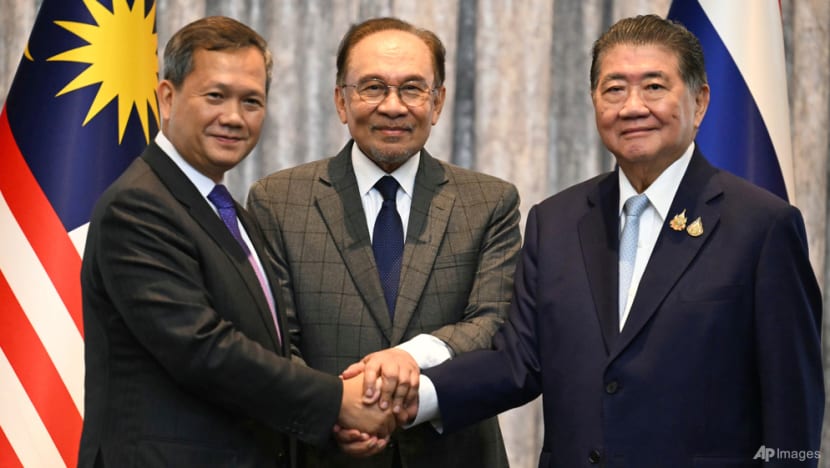
Malaysia's Prime Minister Anwar Ibrahim (centre), Cambodia's Prime Minister Hun Manet (left) and Thailand's acting Prime Minister Phumtham Wechayachai pose for photos after ceasefire talks between Thailand and Cambodia in Putrajaya, Malaysia, on Jul 28, 2025. (Photo: AP/Mohd Rasfan)

This audio is generated by an AI tool.
KUALA LUMPUR: Three Southeast Asian states involved in ending a recent armed conflict in the region - Malaysia, Thailand and Cambodia - hailed the reduction in tariff rates imposed by the United States as a victory after prolonged talks, and a reprieve for their domestic economies.
Experts said the ceasefire, which allowed US President Donald Trump to burnish his peacemaker image, was among several contributing factors that led to substantial tariff discounts for these Southeast Asian countries.
Joanne Lin, who is senior fellow and co-coordinator of the ASEAN Studies Centre at ISEAS–Yusof Ishak Institute, said the timing and geopolitical backdrop were crucial in how Malaysia, Thailand and Cambodia secured the reduced tariff rate.
“Their success came just days after a US-endorsed ceasefire was brokered between Cambodia and Thailand, with Malaysia playing a key mediating role,” she told CNA.
“This allowed Trump to publicly take credit for helping end a regional conflict, bolstering his image as a global dealmaker.”
Other factors cited included the willingness by Malaysia, Cambodia and Thailand to open up market access to the US, and a desire by Washington to move these three countries deemed to be China-friendly further away from Beijing’s orbit of influence.
REGIONAL REACTIONS
Under the new executive order by Trump on Friday, Malaysia now faces a 19 per cent tariff rate on its goods exported to the US, down from 25 per cent.
Fellow Association of Southeast Asian Nations (ASEAN) members Cambodia (36 per cent to 19 per cent) and Thailand (36 per cent to 19 per cent) also struck eleventh-hour trade deals with the US, achieving identical levies to Malaysia.
The Philippines (20 per cent to 19 per cent), Indonesia (32 per cent to 19 per cent) and Vietnam (46 per cent to 20 per cent) had announced earlier deals with the US.
The US tariff rates imposed on Singapore (10 per cent), Brunei (25 per cent), Laos (40 per cent) and Myanmar (40 per cent) remain unchanged.
These levies will come into effect from Aug 7 - a one-week delay from Trump’s original Aug 1 deadline.
The reductions for the trio come after Thailand and Cambodia agreed to an immediate and unconditional ceasefire brokered in Malaysia, with interventions from China and the US, specifically from Trump who had threatened to not make trade deals with them if the fighting had continued.
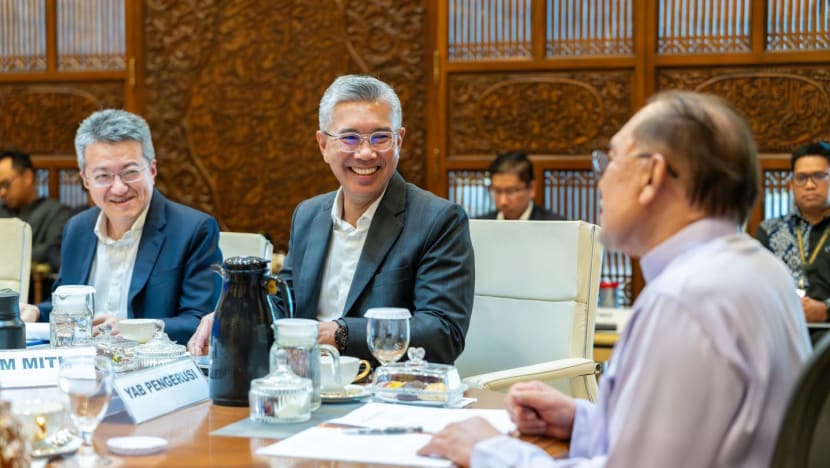
Malaysia is the only one among the three so far to overtly acknowledge that the ceasefire was a factor in the latest tariff rates meted out to the country.
“(Malaysia’s role in facilitating the ceasefire) did definitely help,” said Malaysia’s Investment, Trade and Industry Minister Tengku Zafrul Abdul Aziz at a press conference on Friday, in response to a question by CNA.
“How much? I am not aware. But all the goodwill that was achieved during the call between PM (Anwar Ibrahim) and Donald Trump, where one of the discussions was about the ceasefire, I believe did leave a good impression on Malaysia's role as chairman of ASEAN, in the peacekeeping and ceasefire discussions.”
He also stressed that the tariff negotiation with the US was a “win-win situation” for both countries.
“It also shows the strong bilateral relationship between Malaysia and the US,” he said.
His ministry had earlier depicted Malaysia’s reduced 19 per cent US tariff rate as a “significant achievement”, as other Southeast Asian neighbours welcomed similarly substantial discounts in their own US levies.
MITI said its latest US tariff rate was achieved after a “thorough and methodical negotiating process” with Washington.
“Most importantly, Malaysia had stood firm on various ‘red line’ items, and the 19 per cent tariff rate was achieved without compromising the nation’s sovereign right to implement key policies to support the nation’s socioeconomic stability and growth,” MITI said in a statement.
Malaysia’s rate - six percentage points lower than initially threatened - comes after Anwar said on Thursday he had spoken to Trump over the phone that morning.
Anwar said the pair discussed tariffs "in the spirit and principle of free trade" and that Trump had decided to review the tariff rates imposed on Malaysia.
Trump had issued a letter to Malaysia on Jul 7 saying it faces a 25 per cent tariff rate pending negotiations ahead of Friday’s deadline.
Putrajaya responded by saying it would not budge on “red lines” in tariff negotiations, including in areas of national interest like halal certification and digital trade.
Tengku Zafrul told reporters on Friday that Malaysia rejected US requests to abolish excise duties on alcohol, tobacco and the automotive industry, noting that Malaysia has its own national car with an automotive industry that employs 700,000 people.
Malaysia also turned down a US request to abolish foreign shareholder equity limits in certain strategic sectors, and held firm on its stringent digital platform laws, he said.
On the other hand, the minister acknowledged that Malaysia had agreed to eliminate tariffs on a number of US agricultural products, and facilitate the importation of halal meat from the US.
“Overall, I think given the many things that we stood firm on, we are quite happy that America understands our position,” he added.
“We want the rate to be fair in the region with our ASEAN neighbours. So I think we are quite satisfied, relatively speaking, where we are versus our ASEAN partners.”
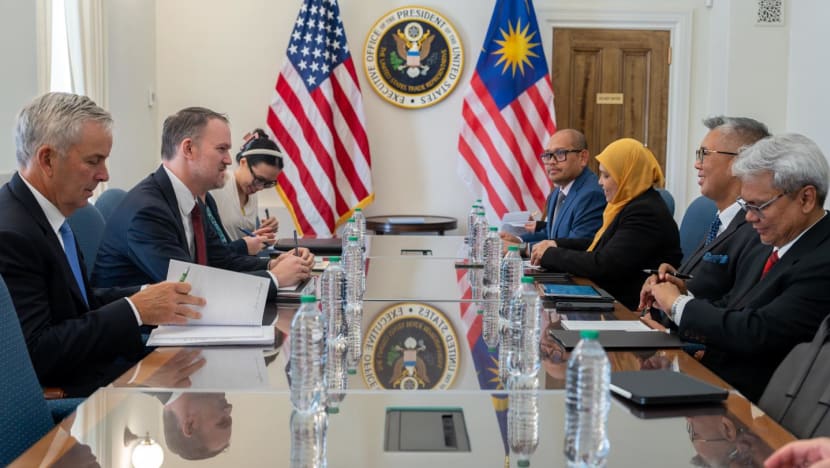
The spokesman of the Thai Prime Minister's Office said the agreed tariff rate will help the country maintain its competitiveness.
Jirayu Chuopsap said it was a “win-win approach” that would ensure Thailand maintains its export base and long-term economic stability.
He added that it would “emphasise Thailand's potential in the world trade arena amidst changes in international trade policy”.
Thailand had been facing a 36 per cent tariff and the prospect of missing the Aug 1 deadline to make a deal with Washington, amid the ongoing border dispute with neighbouring Cambodia.
Meanwhile, Cambodian Prime Minister Hun Manet on Friday welcomed the 19 per cent deal with the US.
“This is the best news for the people and economy of Cambodia to continue to develop the country,” he wrote on social media, also thanking Trump for his “initiative and decisive leadership” in securing the ceasefire and monitoring its implementation directly until permanent peace and normalisation of relations between Cambodia and Thailand is achieved.
Separately, Cambodia’s Deputy Prime Minister Sun Chanthol said that his country’s vital garment and footwear industry has averted a collapse with Washington's reduction of tariff rates on the country’s exports to the US.
Cambodia was initially slapped with a 49 per cent tariff rate, before it was reduced to 36 per cent and later to the eventual 19 per cent.
"First off the bat, I have to thank President Trump for providing a rate that's competitive vis-a-vis our neighbouring countries and express gratitude to President Trump for his noble intervention for a ceasefire and peace," he said, referring to the armed conflict along the Thai-Cambodia land border.
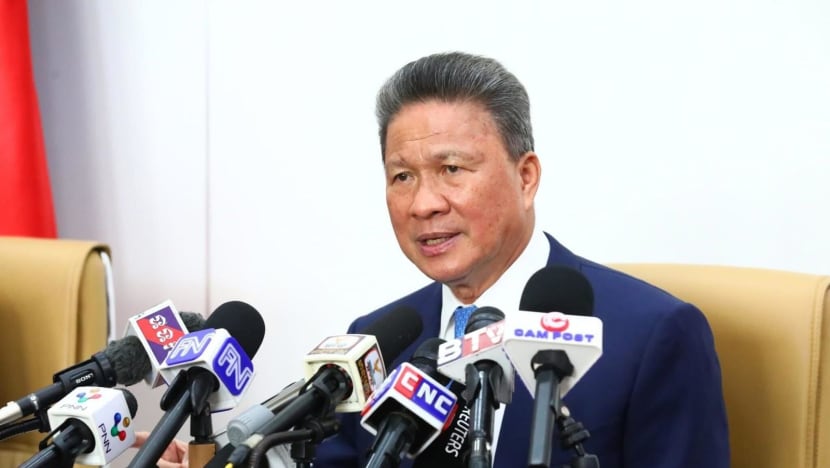
WHAT EXPERTS ARE SAYING
Some experts have noted that Trump is using tariffs beyond the realm of trade and as a foreign policy tool for countries to acquiesce to US demands.
Analyst Adib Zalkapli, who is the managing director of geopolitical consultancy Viewfinder Global Affairs, told CNA that the Thailand-Cambodia ceasefire deal which Malaysia’s PM Anwar brokered was “certainly one of several contributing factors” behind the substantial tariff discounts for the three countries.
“From a political perspective, the ceasefire gave a convenient and symbolic conclusion to the tariff negotiations,” Adib said.
However, he noted that the negotiation process is also complex and influenced by multiple overlapping considerations, and that “no single issue typically makes or breaks a deal”.
“These negotiations usually involve multiple, interconnected issues - the US wanted greater market access and the removal of non-tariff barriers, while the other countries keen to secure an agreement very likely responded by offering selective concession,” he told CNA.
Separately, Lin from ISEAS-Yusof Ishak Institute said that beyond the diplomatic optics of the ceasefire deal, Malaysia, Thailand and Cambodia also showed a “willingness to engage with Trump’s transactional approach to trade”.
“Drawing lessons from fellow ASEAN members like Indonesia and Vietnam (who earlier secured lower rates) they reportedly offered pledges, including greater market access for US goods and commitments to increase American imports.
“Thus, the convergence of strategic timing and economic pragmatism were probably the key factors,” said Lin.
She added that the five ASEAN states that managed to get their respective tariffs reduced to 19 percentage points are seen to be open, flexible and willing to negotiate directly with the US on Washington’s terms.
“Each of them offered concessions, whether by pledging to lower tariffs or non-tariff barriers, increase imports of US goods or expand market access. In short, they were responsive to US demands and willing to transact,” said Lin.
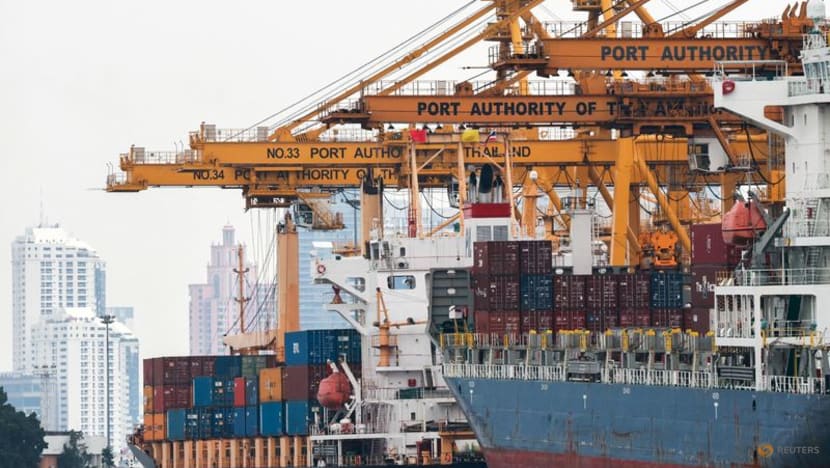
She also pointed out how several Southeast Asian countries, particularly Malaysia, Cambodia and Indonesia are seen as being within China’s sphere of influence, with President Xi Jinping visiting Malaysia, Cambodia and Vietnam earlier this year, underscoring their strategic relevance.
“By engaging with these governments, the US not only secured trade concessions but also reinforced its presence in key parts of the region where influence is being contested with Beijing,” she added.
Anusorn Tamajai, the dean of Rangsit University International College in Thailand, said while the US’ involvement in the ceasefire negotiations was an effective strategy that yielded positive benefits for both sides, and enhanced Washington’s image in Southeast Asia as a peacekeeper, it was likely not the main reason tariff negotiations were successful.
“I believe it was more about trade liberalisation. That was the key - market access - which helped us successfully strike the deal on Trump-era tariffs,” he said.
Despite the more favourable tariff rate, Anusorn said Thailand’s exports are likely to slow down for the second half of 2025. This is primarily because for the first five months, the growth rate has “surged significantly”, he said.
“Part of this was due to the US importers accelerating their imports to avoid tariffs, as it was still unclear what the final tariff rate on Thai products would be,” he said, adding that exports growth was likely to rebound in 2026.
Over in Cambodia’s capital Phnom Penh, Ou Virak, the founder of Future Forum, a public policy think tank, said the situation is like returning to the status quo, given Cambodia’s tariff rate is in line with the rest of the region.
“There's a joke that you don't need to outrun the bear, you just need to be faster than your friend. We expect the landscape will be similar (to previously),” he said.
The impacts on the garment industry, he expected, will be minimal given the US was unlikely to start producing such goods domestically.
“What is interesting is Cambodia's concessions on US goods but we hardly buy anything from the US, so there's nothing major there,” he said, referring to how Cambodia will impose zero tariffs on all American goods.
Meanwhile, former World Trade Organization chief economist Robert Koopma told CNA’s Asia First that the language used around these tariff deals with the US contains “a lot of constructive ambiguity”.
He noted the difference between them and trade agreements, which are usually extremely detailed and have “very specific language”. But the deals made so far have very few details.
He said the deals “allow the US president to declare victory”, while most US trading partners have basically decided not to retaliate to get a relatively lower tariff than what was threatened.
“Both sides of the deal basically get to say, ‘We got something out of this, and it's yet to be determined exactly what it is, and as time passes, we'll both interpret the language in the deal in a way that favours us’."
“(This) likely means more negotiations, more discussions and more uncertainty for trading firms,” added the Hurst senior professorial lecturer at the American University's School of International Service.
Additional reporting by Jack Board






















